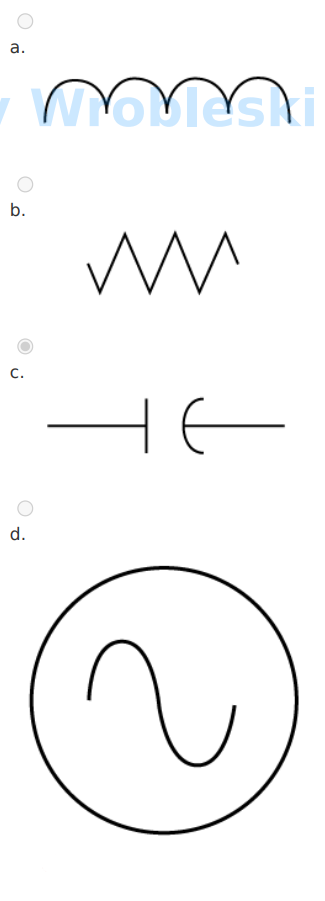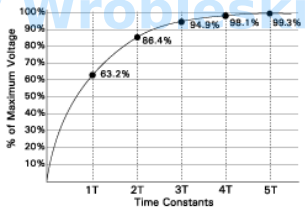-
The physical structure of a(n) ? consists of two conducting surfaces separated by an
insulating material.
a.
capacitor
b.
inductor
c.
insulator
d.
resistor
The correct answer is: capacitor
-
Two conductors feeding a load would not have capacitance.
Select one:
True
False
The correct answer is 'False'.
-
Select the correct option to complete the following sentences.
A(n) ? will not hold its charge indefinitely.
? is the letter designation for capacitance.
One farad ? a practical unit of capacitance.
The unit of capacitance is the farad, abbreviated ? .
When a capacitor of one farad is connected to a source of one volt, its charge is one ? .
Possible answers
is not
C
F
capacitor
coulomb
capacitor
C
is not
F
coulomb
-
One microfarad in decimal form is ? and may be abbreviated ? .
a.
0.000001 F / 1 µF
b.
0.001 F / 1 mF
c.
1.0 F / 1 MF
d.
1000 F / 1 mf
The correct answer is: 0.000001 F / 1 µF
-
One picofarad in decimal form is written as ? F.
The correct answer is: 0.000000000001
-
A picofarad is also called a micromicrofarad and may be abbreviated µµF.
Select one:
True
False
The correct answer is 'True'.
-
One picofarad is one farad times ? .
a.
10
b.
10
c.
10
d.
10
The correct answer is: 10
-

Which of the following is the correct schematic symbol for a capacitor?

-
Select factors that determine the capacitance of a capacitor.
a.
Area of the plates (conducting surfaces)
b.
Distance between the plates
c.
The type of dielectric used (insulating material)
d.
All of the above
The correct answer is: All of the above
-
When a DC voltage source is connected to a capacitor, electrons will be moved from the
plate connected to the ? and deposited on the plate connected to the ? pole. This
will continue until the voltage across the capacitor equals the voltage source.
a.
negative / negative
b.
negative / positive
c.
positive / negative
d.
positive / positive
The correct answer is: positive / negative
-
Current can flow only during the period of time that a capacitor is ? .
I. charged
II. charging
III. discharged
IV. discharging
a.
I.& IV.
b.
I., III., IV.
c.
I.
d.
II.
e.
II. & IV.
The correct answer is: II. & IV.
-
The term ? refers to the force holding an electrical charge across a capacitor's plates.
a.
capacitance
b.
electromagnetic
c.
electromotive force
d.
electrostatic
The correct answer is: electrostatic
-
The ? field is formed when electrons are removed from one plate and deposited on the
other.
a.
electromagnetic
b.
electromotive force
c.
electrostatic
d.
magnetic
The correct answer is: electrostatic
-
Electrons flow through a capacitor.
Select one:
True
False
The correct answer is 'False'.
-
If a capacitor is subjected to a voltage in excess of that for which it is designed, the
electron flow may puncture the insulation, causing an arc-through, which destroys the
? and, therefore, the capacitor.
a.
conductors
b.
dielectric
c.
plates
d.
terminals
The correct answer is: dielectric
-
An AC ammeter indicates a steady current when it is connected in series with a capacitor
across an AC source.
Select one:
True
False
The correct answer is 'True'.
-
In a capacitive circuit, the current will ? the voltage by ? .
a.
lag / 90°
b.
lag / 180°
c.
lead / 90°
d.
lead / 180°
The correct answer is: lead / 90°
-
The type of dielectric used has no effect on a capacitor.
Select one:
True
False
The correct answer is 'False'.
-
A capacitor has the same area of plates and the same distance between the plates. The
capacitance will be ? if air is used instead of insulating oil.
a.
lower
b.
higher
c.
the same
The correct answer is: lower
-
A time constant is the amount of time required to charge a capacitor to ? of the
amount left to reach its full charge.
a.
32.6%
b.
36.2%
c.
62.3%
d.
63.2%
The correct answer is: 63.2%
-
Choose the correct number to answer the following questions.
How many time constants are required to charge a capacitor to a level where it is considered to be fully charged?
How many time constants for a capacitor to fully discharge?
5
5
-
When a capacitor is connected in a circuit with a resistor, the amount of time needed to
charge the capacitor is determined by the ? .
a.
dielectric strength
b.
RC time constant
c.
R/C time constant
d.
resistance to capacitance ratio
The correct answer is: RC time constant
-
Select the equation to find the time constant for a resistive-capacitive circuit.
a. t = C/R
b. t = R/C
c. t = R x C
d. t = R/C x E
t = R x C
-
How long will it take for a 50 µF capacitor to fully charge if it is in a series circuit with a 100 KΩ resistor?
The correct answer is: 25 seconds
-

This curve represents the percentage of charge for each time constant of a capacitor
connected in series with a resistor across DC.
Select one:
True
False
The correct answer is 'True'.


